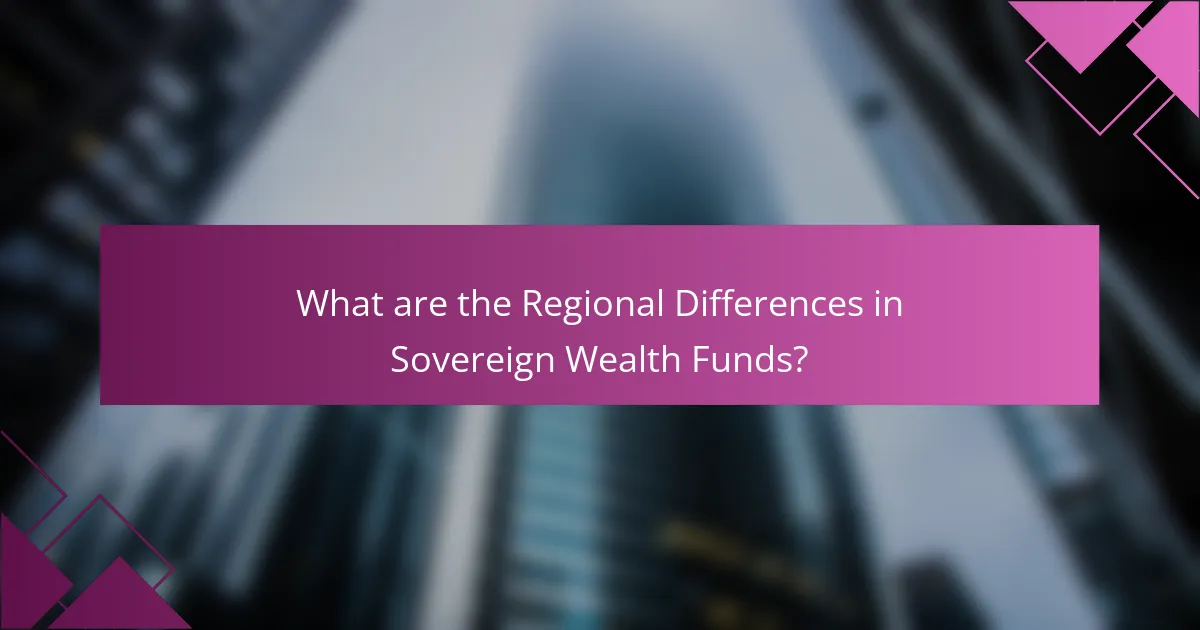
What are Sovereign Wealth Funds and Their Purpose?
Sovereign Wealth Funds (SWFs) are state-owned investment funds. They manage a country’s reserves for various purposes. These funds typically invest in a range of assets, including stocks, bonds, and real estate. The primary purpose of SWFs is to stabilize the economy and generate long-term returns. They can also be used to save for future generations or fund public projects. As of 2023, the total assets managed by SWFs globally exceed $10 trillion. This significant amount underscores their influence in global financial markets.
How do Sovereign Wealth Funds differ from other investment vehicles?
Sovereign Wealth Funds (SWFs) differ from other investment vehicles primarily because they are state-owned investment funds. These funds are typically funded by national revenues, such as surplus reserves from trade, oil exports, or other government income. Unlike private investment funds, SWFs aim to achieve long-term financial returns while also serving broader economic and social objectives.
SWFs often invest in a diverse range of assets, including stocks, bonds, real estate, and infrastructure. Their investment strategies can be influenced by national economic policies and goals, which is not the case for private funds. Additionally, SWFs are generally less constrained by short-term performance pressures compared to other investment vehicles. This allows them to focus on long-term growth and stability.
According to the Sovereign Wealth Fund Institute, as of 2021, there were over 90 SWFs globally, managing assets worth approximately $10 trillion. This scale and backing by state resources provide SWFs with unique advantages in capital availability and investment opportunities.
What are the key characteristics of Sovereign Wealth Funds?
Sovereign Wealth Funds (SWFs) are state-owned investment funds or entities. They invest in a variety of assets to achieve financial returns for their countries. Key characteristics include their source of funding, which typically comes from surplus revenues like oil exports or foreign currency reserves. SWFs often have long-term investment horizons, allowing them to take on higher risks for potentially greater returns.
They are generally managed by governmental or quasi-governmental entities. SWFs are subject to regulatory oversight, ensuring transparency and accountability. Their investment strategies can vary widely, incorporating equities, bonds, real estate, and alternative investments. According to the Sovereign Wealth Fund Institute, as of 2023, the total assets managed by SWFs globally exceed $10 trillion.
Why do countries establish Sovereign Wealth Funds?
Countries establish Sovereign Wealth Funds (SWFs) to manage and invest national savings for future generations. SWFs help stabilize the economy during volatile market conditions. They provide a source of revenue for government budgets. Additionally, these funds can support national development projects. Countries with abundant natural resources often create SWFs to manage resource wealth. For example, Norway’s Government Pension Fund Global was established to invest oil revenues. This approach helps avoid the “resource curse.” By diversifying investments, SWFs reduce dependency on a single revenue source. Ultimately, SWFs aim to enhance long-term economic stability and growth.
What are the primary objectives of Sovereign Wealth Funds?
The primary objectives of Sovereign Wealth Funds (SWFs) are to manage national savings for the purpose of investment. SWFs aim to stabilize the economy during fluctuations in revenue, particularly from natural resources. They also seek to diversify national investments to reduce risk. Additionally, SWFs aim to generate long-term financial returns for future generations. They often invest in various asset classes, including equities, bonds, and real estate. Many SWFs also focus on enhancing the country’s global economic presence. Overall, SWFs play a crucial role in national financial strategies.
How do Sovereign Wealth Funds contribute to national economic stability?
Sovereign Wealth Funds (SWFs) contribute to national economic stability by providing a buffer against economic shocks. They accumulate and manage national savings, often derived from commodity revenues or trade surpluses. This accumulation allows countries to stabilize their economies during downturns. For example, during the 2008 financial crisis, many SWFs invested in distressed assets, helping to stabilize financial markets. Additionally, SWFs can support government budgets during periods of low revenue. They also promote long-term economic growth through investments in infrastructure and development projects. Countries with robust SWFs often experience reduced volatility in their economic cycles. This stability can enhance investor confidence, attracting foreign direct investment. Overall, SWFs play a critical role in managing national wealth and mitigating economic risks.
What role do Sovereign Wealth Funds play in global financial markets?
Sovereign Wealth Funds (SWFs) are state-owned investment funds that play a significant role in global financial markets. They provide liquidity and stability to markets by investing in a wide range of assets, including equities, bonds, real estate, and infrastructure. SWFs are often used by countries to manage surplus revenues, particularly from natural resources. For instance, the Norway Government Pension Fund Global, one of the largest SWFs, had assets exceeding $1 trillion as of 2023. This substantial capital allows SWFs to influence market trends and provide long-term investment perspectives. Additionally, SWFs can stabilize economies during financial crises by acting as counter-cyclical investors. Their investments often lead to increased foreign direct investment in developing economies, fostering growth and development. Overall, SWFs are crucial players in enhancing market efficiency and promoting economic stability globally.

What are the Regional Differences in Sovereign Wealth Funds?
Regional differences in sovereign wealth funds (SWFs) are significant. These differences arise from varying economic structures, investment strategies, and regulatory environments. For example, Middle Eastern SWFs often focus on energy revenues, while Asian funds may prioritize diversification. North American SWFs typically emphasize risk-adjusted returns through a mix of asset classes. Each region’s historical context influences its fund management style. In Europe, funds often prioritize sustainable investing. Research indicates that these regional characteristics impact overall performance and asset allocation strategies.
How do Sovereign Wealth Funds vary by region?
Sovereign Wealth Funds (SWFs) vary significantly by region in terms of size, investment strategy, and asset allocation. For instance, Middle Eastern SWFs, such as the Abu Dhabi Investment Authority, are typically large and heavily invested in oil and gas assets. In contrast, Asian SWFs, like Singapore’s GIC, diversify their portfolios across various sectors, including technology and real estate.
European SWFs often focus on sustainable investments, reflecting regional priorities for environmental responsibility. North American SWFs, such as the Alaska Permanent Fund, emphasize returns from natural resources while also investing in public equities.
The geographical context influences these strategies. For example, countries with abundant natural resources tend to have larger funds focused on commodity investments. In contrast, nations with developed economies may prioritize diversification and sustainability.
According to the Sovereign Wealth Fund Institute, as of 2023, the largest SWFs are predominantly located in the Middle East and Asia, underscoring regional disparities in fund size and investment focus.
What are the major Sovereign Wealth Funds in different regions?
The major Sovereign Wealth Funds (SWFs) in different regions include the Government Pension Fund Global of Norway, the Abu Dhabi Investment Authority of the UAE, and the China Investment Corporation. In North America, the Alaska Permanent Fund is significant. In Asia, the Government of Singapore Investment Corporation plays a crucial role. The Qatar Investment Authority is notable in the Middle East. In Africa, the Nigeria Sovereign Investment Authority is a key player. These funds manage vast assets, with the Government Pension Fund Global holding over $1 trillion. The Abu Dhabi Investment Authority also manages over $700 billion. These SWFs are vital for their respective economies and investment strategies.
How do cultural and economic factors influence regional fund strategies?
Cultural and economic factors significantly influence regional fund strategies. Cultural values shape investment priorities and risk tolerance. For instance, countries with a collectivist culture may prioritize social welfare investments. Economic factors, such as GDP growth and inflation rates, affect asset allocation decisions. Regions with stable economies often invest in diverse asset classes. In contrast, areas facing economic uncertainty may focus on safer, liquid investments. Historical data shows that oil-rich nations invest heavily in infrastructure and real estate. Conversely, emerging markets might prioritize technology and innovation sectors. These influences create distinct regional fund strategies tailored to specific cultural and economic contexts.
What are the implications of regional differences on fund performance?
Regional differences significantly impact fund performance. Variations in economic conditions, regulatory environments, and market maturity across regions lead to differing returns. For instance, funds in emerging markets often experience higher volatility compared to those in developed markets. Additionally, geopolitical risks can influence investment strategies and outcomes. Historical data shows that funds in regions with stable governance tend to outperform those in politically unstable areas. According to the International Monetary Fund, regional economic growth rates also affect investment opportunities and returns. Thus, understanding these regional implications is crucial for effective fund management and strategy development.
How do geopolitical factors affect Sovereign Wealth Fund operations?
Geopolitical factors significantly influence Sovereign Wealth Fund (SWF) operations. These funds often adjust their investment strategies based on political stability and international relations. For example, SWFs may avoid investing in regions experiencing conflict or sanctions. This avoidance is due to the heightened risk of asset devaluation. Additionally, geopolitical tensions can lead to changes in regulatory environments. SWFs must navigate these changes to protect their investments. Historical instances, such as the impact of U.S.-China trade tensions, illustrate this dynamic. During such tensions, many SWFs re-evaluated their exposure to U.S. assets. Overall, geopolitical factors play a crucial role in shaping the operational landscape of Sovereign Wealth Funds.
What trends can be observed in regional asset allocations?
Regional asset allocations show a trend towards diversification across various asset classes. Sovereign wealth funds are increasingly investing in alternative assets such as real estate and private equity. This shift aims to enhance returns and reduce risk exposure.
Emerging markets are receiving greater allocations as investors seek growth opportunities. In contrast, developed markets are seeing a more cautious approach.
Data from the Sovereign Wealth Fund Institute indicates that as of 2022, 30% of global sovereign wealth fund assets are allocated to equities, while alternatives account for 25%.
These trends reflect a strategic response to market volatility and changing economic conditions.

What are the Asset Allocation Trends in Sovereign Wealth Funds?
Asset allocation trends in sovereign wealth funds show a shift towards diversification and alternative investments. Recent data indicates that many funds are increasing their allocations to private equity, real estate, and infrastructure. For instance, the Sovereign Wealth Fund Institute reported that private equity allocations have risen to nearly 10% of total assets in recent years. Additionally, emerging markets are becoming a more attractive investment option, reflecting a growing trend towards geographical diversification.
Furthermore, there is a notable increase in sustainable and responsible investing among these funds. A 2023 report by the International Forum of Sovereign Wealth Funds highlighted that over 30% of funds now incorporate ESG (Environmental, Social, and Governance) criteria into their investment strategies.
These trends demonstrate a clear evolution in the investment strategies of sovereign wealth funds, driven by the need for higher returns and risk management in a changing global economic landscape.
How do Sovereign Wealth Funds decide on asset allocation strategies?
Sovereign Wealth Funds (SWFs) decide on asset allocation strategies based on investment objectives, risk tolerance, and market conditions. They typically seek to balance risk and return while meeting the long-term financial goals of their respective governments. SWFs analyze macroeconomic indicators and geopolitical factors to inform their decisions.
Additionally, they may employ strategic asset allocation, which involves setting target allocations for various asset classes. Tactical asset allocation may also be used, allowing for short-term adjustments based on market opportunities.
Research shows that SWFs often diversify their portfolios across equities, fixed income, real estate, and alternative investments. For instance, the International Working Group of Sovereign Wealth Funds emphasizes the importance of maintaining a diversified portfolio to mitigate risks.
Overall, the asset allocation strategies of SWFs are influenced by their unique mandates and the economic contexts in which they operate.
What types of assets are commonly held by Sovereign Wealth Funds?
Sovereign Wealth Funds commonly hold a diverse range of assets. These assets typically include equities, fixed income securities, real estate, and alternative investments. Equities represent shares in publicly traded companies. Fixed income securities consist of government and corporate bonds. Real estate investments may include commercial properties and infrastructure projects. Alternative investments can encompass private equity, hedge funds, and commodities. According to the Sovereign Wealth Fund Institute, as of 2023, the total assets managed by Sovereign Wealth Funds exceed $10 trillion, reflecting their significant role in global finance.
How have asset allocation trends evolved over the past decade?
Asset allocation trends have shifted significantly over the past decade. Investors have increasingly diversified their portfolios. There has been a notable rise in alternative investments. This includes private equity, real estate, and hedge funds. Traditional asset classes, like stocks and bonds, have seen reduced allocations. The average allocation to equities has decreased from 60% to around 50%. Conversely, allocations to alternatives have increased from 15% to approximately 30%. Global economic uncertainties have driven this shift. Factors include low interest rates and market volatility. Additionally, ESG (Environmental, Social, and Governance) considerations have influenced investment choices. Investors are now prioritizing sustainability alongside financial returns. These trends reflect a broader evolution in investment strategies and risk management.
What factors influence asset allocation decisions in Sovereign Wealth Funds?
Asset allocation decisions in Sovereign Wealth Funds are influenced by multiple factors. These factors include investment objectives, risk tolerance, and liquidity requirements. Investment objectives dictate the desired returns and time horizon for investments. Risk tolerance determines the acceptable level of volatility and potential losses. Liquidity requirements ensure that funds can meet short-term obligations.
Additionally, macroeconomic conditions play a significant role. Economic growth rates, inflation, and interest rates affect the performance of various asset classes. Political stability and regulatory frameworks in the fund’s home country also influence decisions.
Furthermore, diversification strategies are crucial. Funds aim to spread investments across different asset classes and geographies to mitigate risks. Historical performance data informs future allocation strategies by analyzing past returns and volatility.
Finally, stakeholder preferences, including government policies and public opinion, can impact asset allocation. These factors collectively shape the strategic direction of Sovereign Wealth Funds.
How do market conditions impact asset allocation strategies?
Market conditions significantly influence asset allocation strategies. Economic indicators, such as interest rates and inflation, dictate investment choices. In bullish markets, investors may favor equities for higher returns. Conversely, in bearish markets, they might shift towards safer assets like bonds. Global events, such as geopolitical tensions, can also affect market stability. During uncertain times, diversification becomes crucial to mitigate risks. Historical data shows that asset allocation adjustments can enhance portfolio resilience. For example, during the 2008 financial crisis, many investors reallocated to defensive sectors to preserve capital.
What role does risk tolerance play in asset allocation for these funds?
Risk tolerance significantly influences asset allocation for sovereign wealth funds. It determines how much risk a fund is willing to accept in pursuit of returns. Funds with high risk tolerance may allocate more to equities and alternative investments. Conversely, those with low risk tolerance typically favor bonds and cash equivalents.
This approach aligns with the fund’s investment objectives and time horizon. For instance, a fund focused on long-term growth might embrace higher volatility. In contrast, a fund prioritizing capital preservation would seek stability.
Historical data shows that funds adjust their allocation based on changing risk appetites. For example, during market downturns, many funds shift toward safer assets to mitigate losses. This dynamic illustrates the critical role of risk tolerance in shaping investment strategies.

What is the Historical Performance of Sovereign Wealth Funds?
Sovereign wealth funds (SWFs) have historically shown varying performance based on regional and economic factors. Over the last two decades, the average annual return for SWFs has been approximately 6-8%. Performance is influenced by asset allocation strategies, with funds investing in a mix of equities, bonds, and alternative assets. For example, the Norway Government Pension Fund Global, one of the largest SWFs, reported a return of 14.5% in 2020. In contrast, some funds in emerging markets have experienced more volatility. The overall trend indicates that SWFs tend to perform better during periods of economic growth. Additionally, diversification across global markets has been a key strategy for enhancing returns.
How have Sovereign Wealth Funds performed historically?
Sovereign Wealth Funds (SWFs) have historically shown strong performance, often exceeding benchmark returns. According to the Sovereign Wealth Fund Institute, the average annual return for SWFs from 2000 to 2020 was approximately 6.5%. During this period, many SWFs benefited from rising global equity markets and diversified asset allocations. For instance, the Government Pension Fund of Norway reported a return of 7.4% over the same timeframe. Additionally, SWFs have adjusted their strategies in response to market conditions, increasing allocations to alternative investments. This adaptability has contributed to their resilience during economic downturns. Overall, historical data indicates that SWFs have effectively managed assets, yielding favorable long-term returns.
What are the benchmarks used to assess their performance?
Sovereign wealth funds’ performance is assessed using various benchmarks. Common benchmarks include market indices like the MSCI World Index and the S&P 500. These indices provide a standard for comparing returns. Additionally, customized benchmarks reflecting specific investment strategies are often used. Risk-adjusted metrics, such as the Sharpe ratio, help evaluate performance relative to risk taken. Performance is also measured against peer funds or similar investment portfolios. These benchmarks help stakeholders understand the effectiveness of fund management. They ensure transparency and accountability in fund operations.
How do historical returns compare across different funds?
Historical returns across different funds vary significantly based on their investment strategies and asset allocations. For instance, equity funds typically yield higher returns compared to bond funds over the long term. According to the S&P Dow Jones Indices, the average annual return for U.S. equity funds over the past decade was approximately 14%, while bond funds averaged around 5%.
Regional differences also play a role. For example, funds in emerging markets often experience higher volatility but can provide greater returns, averaging around 10% annually. In contrast, developed market funds tend to offer steadier but lower returns.
Additionally, funds focused on specific sectors, such as technology, have outperformed general market indices, with some tech-focused funds reporting returns exceeding 20% annually in recent years. Historical data from Morningstar indicates that the top-performing funds consistently leverage unique investment opportunities.
Overall, the comparative analysis reveals that while historical returns differ across funds, factors such as investment focus, market conditions, and regional economic stability are critical in determining performance outcomes.
What lessons can be learned from the historical performance of Sovereign Wealth Funds?
Historical performance of Sovereign Wealth Funds (SWFs) reveals several key lessons. First, diversification is crucial for risk management. Funds that invested across various asset classes, such as equities, bonds, and real estate, generally performed better. For example, the Government Pension Fund of Norway achieved strong returns through a diversified portfolio.
Second, long-term investment strategies yield better outcomes. SWFs that maintained a long-term perspective, like the Abu Dhabi Investment Authority, often weathered market volatility effectively. Their focus on sustainable growth led to consistent returns over decades.
Third, transparency and governance are essential. Funds with robust governance frameworks tend to build trust and attract better investment opportunities. The Kuwait Investment Authority exemplifies this by adhering to high standards of accountability.
Lastly, adapting to changing economic conditions is vital. SWFs that adjusted their strategies in response to global market shifts, such as the Singapore Investment Corporation, managed to capitalize on emerging opportunities. This adaptability has been crucial for maintaining performance.
In summary, key lessons from the historical performance of SWFs include the importance of diversification, long-term strategies, strong governance, and adaptability to market changes.
How have past performance trends shaped current investment strategies?
Past performance trends have significantly influenced current investment strategies. Historical data reveals that sovereign wealth funds adapt their asset allocations based on previous returns. For instance, funds that experienced high returns from equities in the past tend to increase their equity allocations. Conversely, underperformance in certain asset classes often leads to reduced investments in those areas.
Additionally, trends indicate a shift towards diversification to mitigate risks observed in past downturns. The 2008 financial crisis prompted many funds to reassess their risk management strategies. They now prioritize alternative investments to enhance returns and reduce volatility.
Data from the Sovereign Wealth Fund Institute shows that funds have increasingly allocated towards technology and renewable energy sectors in response to past growth patterns. Overall, past performance trends play a crucial role in shaping the strategic decisions of sovereign wealth funds today.
What are the common challenges faced by Sovereign Wealth Funds in achieving their goals?
Sovereign Wealth Funds face several common challenges in achieving their goals. One major challenge is political risk, which can affect investment decisions and strategies. Fluctuations in government policies can lead to instability in investment environments. Another challenge is market volatility, which can impact asset values and returns. Economic downturns can significantly reduce the performance of investments. Additionally, transparency and governance issues can hinder effective management and accountability. Lack of clear guidelines may lead to misalignment with national interests. Furthermore, competition for attractive investment opportunities can limit options. High demand for limited resources can drive up prices and reduce potential returns. Lastly, managing diverse portfolios across various asset classes can be complex. This complexity may lead to difficulties in maintaining optimal asset allocation.
What best practices can enhance the effectiveness of Sovereign Wealth Funds?
Sovereign Wealth Funds can enhance their effectiveness by implementing best practices such as adopting transparent governance structures. Transparency fosters accountability and builds public trust. Another best practice is developing a clear investment strategy aligned with national economic goals. This alignment ensures that funds are utilized effectively for long-term benefits. Diversification of investment portfolios is also crucial. It reduces risks and increases potential returns across various asset classes.
Regular performance evaluation is essential for effective management. This evaluation allows funds to adapt strategies based on market conditions. Engaging with experienced investment managers can also enhance decision-making. Their expertise can lead to better investment choices. Lastly, fostering collaboration with other sovereign funds can promote knowledge sharing and best practices.
These practices are supported by evidence showing that well-governed funds with clear strategies outperform less organized counterparts. For instance, the Norwegian Government Pension Fund Global is often cited for its transparent practices and strong governance, leading to successful long-term returns.
Sovereign Wealth Funds (SWFs) are state-owned investment entities that manage national reserves to achieve economic stability and generate long-term returns. This article provides a comparative analysis of SWFs, focusing on regional differences in fund strategies, asset allocation trends, and historical performance. It examines how various economic and cultural factors influence the investment approaches of SWFs across different regions, highlights the evolution of asset allocation strategies towards diversification and alternative investments, and discusses the historical performance of these funds, revealing key lessons and challenges they face. The insights aim to enhance understanding of SWFs’ roles in global finance and their impact on national economies.
